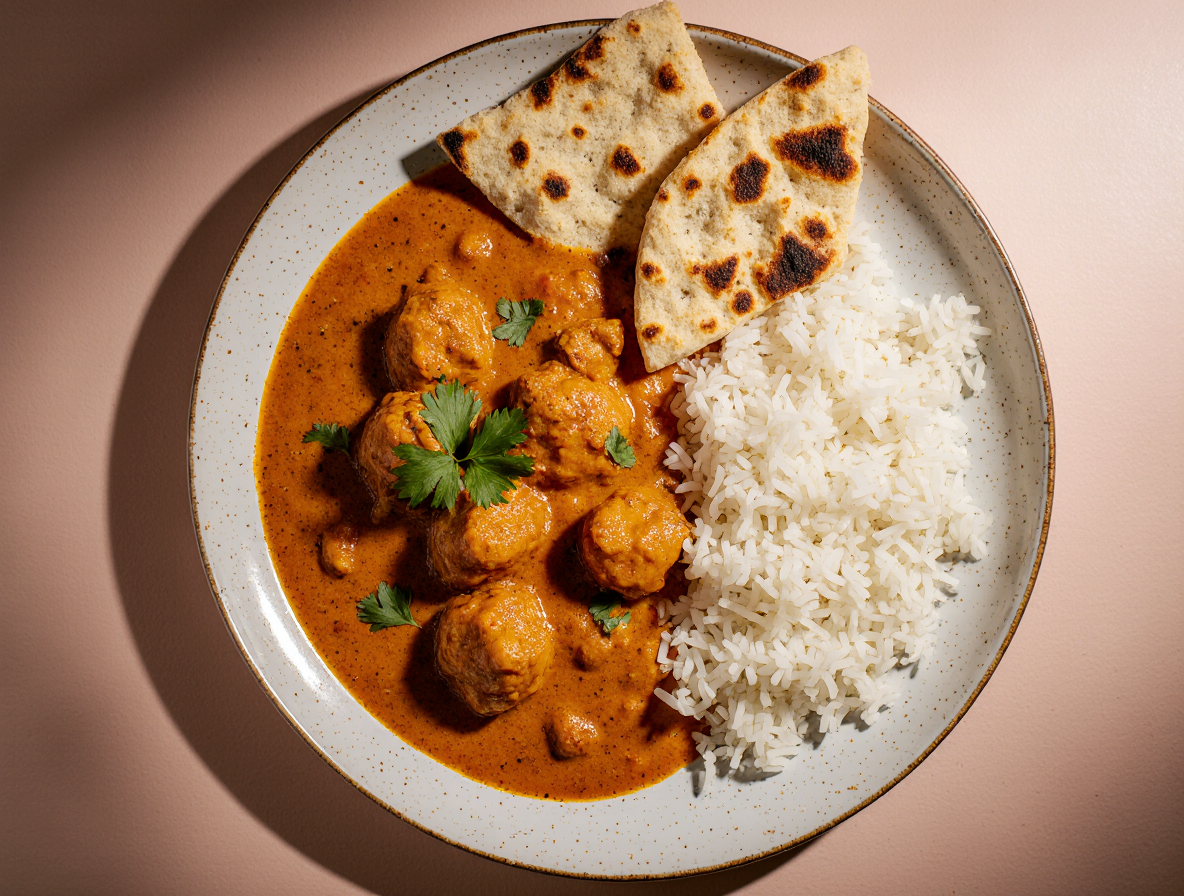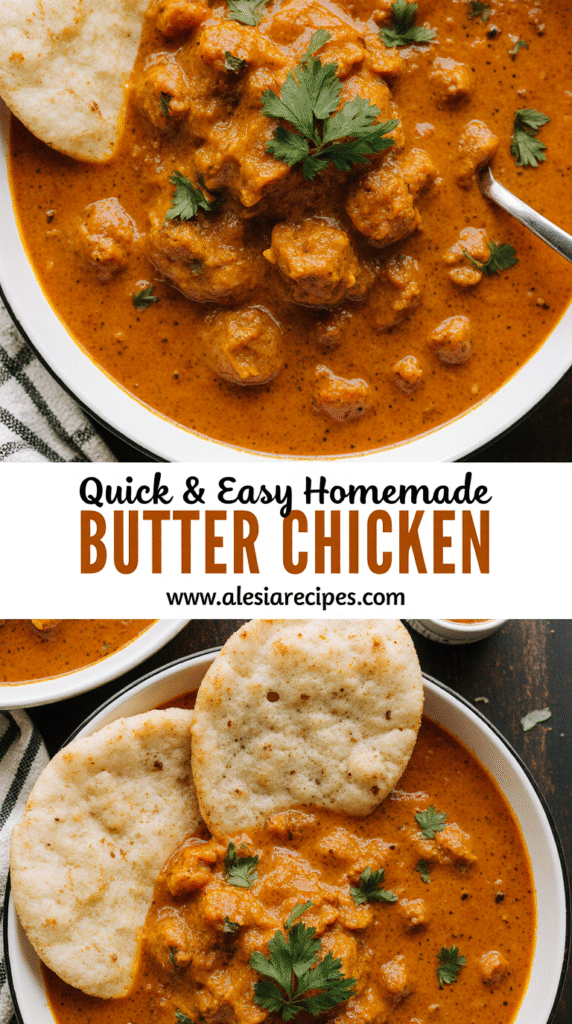How to Make Easy Butter Chicken: A Foolproof 20-Minute Recipe
Looking for an easy butter chicken recipe that delivers restaurant-quality flavor in just 20 minutes? This creamy, flavor-packed dish requires only one pan and delivers 880 calories of rich, satisfying goodness per serving.
Despite what many think, making homemade butter chicken doesn’t require culinary expertise or hours in the kitchen. In fact, our simplified version creates better than restaurant quality butter chicken without an overwhelming list of ingredients. The sauce turns out super silky, buttery, and mildly spicy, making it perfect for family dinners. By spending just 15 minutes caramelizing onions and garlic, you’ll develop those deep, complex flavors that make quick butter chicken so irresistible.
We’ve streamlined this classic Indian dish to be deeply flavorful and rich while eliminating unnecessary steps. If you’ve got 30 minutes and basic pantry ingredients, you can create this no-fuss one-pan butter chicken that will have everyone asking for seconds!
Gathering Your Ingredients
Success with this 20-minute butter chicken begins with gathering the right ingredients. The perfect blend of spices, proteins, and creaminess creates that signature richness without hours of cooking.
Essential spices and pantry items
For authentic flavor, you’ll need a combination of aromatic spices. Garam masala serves as the foundation—this warming spice blend typically includes cinnamon, cardamom, cloves, and black pepper. Additionally, you’ll need turmeric for color, cumin and coriander to balance flavors, and Kashmiri red chili powder for mild heat.
One ingredient that truly elevates homemade butter chicken is kasuri methi (dried fenugreek leaves). Although optional, these leaves add an unmistakable aromatic quality that distinguishes restaurant-quality butter chicken.
Other pantry essentials include garlic, ginger, and tomato paste or tomato sauce to create that vibrant base. For convenience, look for tomato passata (pureed tomatoes) which creates a smoother sauce without extra steps.
Choosing the right cut of chicken
Boneless skinless chicken thighs are traditionally preferred for butter chicken because they remain tender and juicy throughout cooking. The extra fat ensures moist, flavorful meat even with quick cooking methods. Nevertheless, boneless chicken breasts work perfectly fine if you prefer a leaner option, though they may become slightly drier.
For this quick recipe, cut your chicken into 1-inch cubes to ensure even, rapid cooking. This uniform size helps everything cook at the same rate—essential for a 20-minute timeline.
Cream, tomato, and butter: the flavor base
The signature butter chicken taste comes from three key ingredients. Heavy cream (¼ to ⅓ cup) provides richness and helps mellow the acidity of tomatoes. Butter (preferably unsalted) gives the dish its namesake velvety texture—about 3-4 tablespoons creates the perfect balance. Finally, tomato sauce or passata forms the foundation of the sauce, providing both color and tanginess.
Optional ingredients and substitutions
For dairy-free versions, substitute heavy cream with full-fat coconut milk and butter with olive oil or a plant-based alternative. Furthermore, cashews blended into a smooth paste can replace cream entirely, adding natural creaminess.
For additional flavor, yogurt tenderizes the chicken beautifully when used as a quick marinade. Plain Greek yogurt works especially well due to its thickness and tanginess.
Those seeking more richness can add 15-20 soaked cashews blended into a paste, which creates a luxurious texture without additional dairy.
Prepping for a Quick Cook
The difference between mediocre and magnificent butter chicken often lies in the preparation. Proper cutting, seasoning, and organization can transform your 20-minute butter chicken from good to extraordinary.
Cutting and seasoning the chicken
Initially, slice your chicken into uniform ½-inch to 1½-inch pieces, ensuring they cook evenly and quickly. For optimal results, pat the chicken pieces dry with paper towels before adding seasonings. This crucial step promotes better browning during cooking.
For the base seasoning, combine red chili powder, salt, and lemon juice directly on the chicken, mixing well and letting it rest for 20 minutes. This preliminary seasoning ensures your chicken absorbs flavors thoroughly before adding the remaining spices.
Before cooking, I recommend removing marinated chicken from the refrigerator about 30 minutes prior to cooking. This allows the chicken to reach room temperature, subsequently ensuring more even cooking throughout.
Pre-mixing the spice blend
Creating your own butter chicken spice blend lets you control the heat level and customize flavors to suit your family’s preferences. A classic blend typically includes:
- Ground paprika for color and mild flavor
- Ground cardamom for sweet, floral notes
- Ground coriander for fresh, citrusy taste
- Ground cumin for earthy warmth
- Ground turmeric for color and earthiness
- Optional additions: fennel seeds, star anise, or kasuri methi (dried fenugreek leaves)
Combine all spices in a small bowl or spice grinder until well mixed. Pre-mixing your spice blend beforehand saves precious minutes during the cooking process, particularly when aiming for a 20-minute meal.
Tips for faster prep and cleanup
To streamline preparation, consider these time-saving techniques:
First, use a non-stick or well-seasoned cast iron skillet to prevent sticking and facilitate easier cleanup. Henceforth, clean as you go, washing utensils and clearing workspace while the chicken marinates.
Store leftover spice blend in an airtight container for future use. This strategy creates a ready-to-use mix that makes your next batch of butter chicken even quicker to prepare.
For truly minimal cleanup, marinate chicken in a zip-top bag instead of a bowl. This method eliminates one dish to wash and ensures even coating of the marinade throughout the chicken pieces.
Lastly, pre-measure all ingredients before starting to cook. Setting up this “mise en place” system means your quick butter chicken recipe will flow smoothly without any frantic measuring during the cooking process.
Cooking the 20-Minute Butter Chicken
The magic of this quick butter chicken happens in the pan where flavors meld together in minutes. With proper technique, even beginners can create restaurant-worthy results.
Step 1: Sauté aromatics and spices
Begin by melting 2 tablespoons of butter in a large skillet over medium heat. Once melted, add finely chopped onions and cook until they caramelize to a golden brown, typically 3-4 minutes for a quick version or 15 minutes for deeper flavor. Add minced garlic and grated ginger, cooking for approximately 30-60 seconds until fragrant. Immediately add your spice blend (garam masala, turmeric, cumin, paprika) and stir constantly for about a minute, allowing the spices to bloom without burning.
Step 2: Add chicken and tomato base
Next, add your chicken pieces directly to the spiced mixture. Cook for 5-6 minutes until the chicken is almost cooked through but not completely done. Simultaneously add tomato paste and stir for about a minute until it darkens slightly. Pour in tomato sauce or passata along with a small amount of water or stock to create the base of your sauce.
Step 3: Simmer with cream and finish with butter
After the sauce begins to thicken, reduce heat to low and carefully stir in heavy cream. Allow the mixture to simmer gently for 8-10 minutes, stirring occasionally. Throughout this process, remember that boiling can cause cream to separate. Accordingly, maintain a gentle simmer. Just before serving, swirl in an additional tablespoon of butter for extra richness and velvety texture.
How to avoid overcooking the chicken
The key to juicy chicken is proper temperature control. For absolute precision, use a food thermometer—chicken is perfectly cooked at 75°C/167°F. Moreover, cook chicken initially until most pink is gone but not completely, as it will finish cooking in the sauce. Another effective technique is cooking chicken at high temperature briefly to sear the outside, which enhances flavor while keeping the inside tender.
Serving and Storing Your Dish
The perfect finish to your quick butter chicken involves thoughtful serving and proper storage for those delicious leftovers.
Best sides: rice, naan, or both?
Traditionally, butter chicken shines when paired with steamed basmati rice, which absorbs the rich sauce beautifully. Certainly naan bread offers another classic option, ideal for scooping up every last bit of sauce. Many households actually serve both since they complement the dish differently. For variation, try jasmine rice, coconut lime rice, or even serve your homemade butter chicken over fries or pasta for a fusion twist.
Garnishing for flavor and presentation
Fresh cilantro sprinkled over your 20-minute butter chicken adds vibrant color and freshness. For special occasions, swirl a little cream on top just before serving. Lime wedges alongside provide a bright, acidic contrast that balances the dish’s richness. These simple garnishes elevate both presentation and flavor profile.
How to store leftovers
Allow your quick butter chicken to cool slightly before transferring to airtight containers. Properly stored, it keeps in the refrigerator for 3-4 days. For longer storage, freeze for up to 3 months. Many enthusiasts claim the flavors actually intensify overnight.
Reheating tips for next-day meals
Reheat stovetop on low heat with occasional stirring for best texture. Alternatively, microwave in short intervals, stirring between each. If the sauce has thickened, adding a splash of water or cream restores its silky consistency.
Conclusion
This easy butter chicken recipe truly transforms a traditionally complex dish into an accessible weeknight meal. With just one pan and about 20 minutes, you can create a restaurant-quality dish that delivers rich, creamy flavors without the fuss of complicated techniques or ingredient lists.
The secret lies primarily in proper preparation. Cutting chicken uniformly, pre-mixing your spice blend, and organizing your ingredients before cooking makes all the difference between a good and outstanding butter chicken. Additionally, the careful layering of flavors—from caramelized onions to bloomed spices and that final swirl of butter—creates depth that belies the quick cooking time.
What makes this recipe particularly special is its flexibility. You can adjust spice levels, substitute ingredients for dietary needs, or even prepare components ahead of time. Therefore, busy families can still enjoy authentic Indian cuisine without spending hours in the kitchen.
Remember that butter chicken actually tastes better the next day as flavors continue to develop, so don’t hesitate to make extra. The leftovers store beautifully and provide an even more flavorful meal with minimal effort.
We hope this foolproof recipe becomes a regular part of your meal rotation. After all, few dishes offer such impressive returns on such modest time investment. Simply gather your ingredients, follow these straightforward steps, and prepare to amaze your family with butter chicken that rivals your favorite restaurant’s version—all while spending less time in the kitchen and more time enjoying the meal.
FAQs
Q1. What are the key ingredients for making butter chicken? The essential ingredients for butter chicken include boneless chicken, butter, heavy cream, tomato sauce or passata, and a blend of spices like garam masala, turmeric, cumin, and coriander. Garlic, ginger, and onions are also crucial for building flavor.
Q2. How can I make an easy chicken curry in under 30 minutes? To make a quick chicken curry, start by sautéing onions, garlic, and ginger. Add your spices, then brown the chicken pieces. Pour in tomato sauce and coconut milk or cream, simmer until the chicken is cooked through, and finish with a squeeze of lemon juice. The entire process should take about 20-30 minutes.
Q3. What are some common mistakes to avoid when making butter chicken? Common mistakes include overcooking the chicken, using too much butter, forgetting to add kasuri methi (dried fenugreek leaves), not straining the gravy for a smooth texture, and rushing the cooking process. Taking time to develop flavors and cooking the chicken properly are key to a delicious butter chicken.
Q4. Can I make butter chicken dairy-free? Yes, you can make a dairy-free version of butter chicken. Substitute heavy cream with full-fat coconut milk and replace butter with olive oil or a plant-based alternative. You can also use cashews blended into a smooth paste to add creaminess without dairy.
Q5. How long can I store leftover butter chicken? Leftover butter chicken can be stored in an airtight container in the refrigerator for 3-4 days. For longer storage, you can freeze it for up to 3 months. Many people find that the flavors actually intensify overnight, making leftovers even more delicious.


